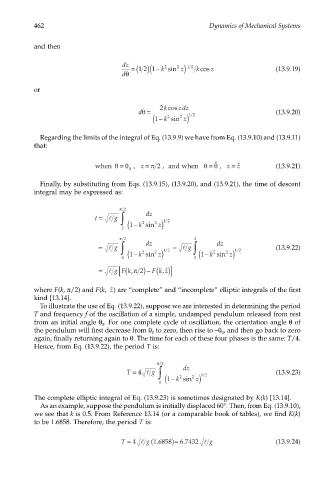Page 481 - Dynamics of Mechanical Systems
P. 481
0593_C13_fm Page 462 Monday, May 6, 2002 3:21 PM
462 Dynamics of Mechanical Systems
and then
dz 2 2 z) 1 2
/
12
dθ = ( ) − (1 k sin kcos z (13.9.19)
or
dθ= 2 kcos zdz 12 (13.9.20)
/
2
− (1 k sin 2 z)
Regarding the limits of the integral of Eq. (13.9.9) we have from Eq. (13.9.10) and (13.9.11)
that:
ˆ
=
=
when θθ , z = π 2 , and when θ θ , z = ˆ z (13.9.21)
0
Finally, by substituting from Eqs. (13.9.15), (13.9.20), and (13.9.21), the time of descent
integral may be expressed as:
π / 2
∫ dz
t = l g 2 2 z) 12
/
z ˆ − (1 k sin
π / 2 z ˆ
= l g ∫ 2 dz 2 z) 12 − l g ∫ 2 dz 2 z) 12 (13.9.22)
/
/
0 − (1 k sin 0 − (1 k sin
F k z)]
= l gF k ( [ ,π 2 ) − ( , ˆ
where F(k, π/2) and F(k, ) are “complete” and “incomplete” elliptic integrals of the first
ˆ z
kind [13.14].
To illustrate the use of Eq. (13.9.22), suppose we are interested in determining the period
T and frequency f of the oscillation of a simple, undamped pendulum released from rest
from an initial angle θ . For one complete cycle of oscillation, the orientation angle θ of
0
the pendulum will first decrease from θ to zero, then rise to –θ , and then go back to zero
0
0
again, finally returning again to θ. The time for each of these four phases is the same: T/4.
Hence, from Eq. (13.9.22), the period T is:
π / 2
T = 4 l g ∫ 2 dz 2 z) 12 (13.9.23)
/
0 − (1 k sin
The complete elliptic integral of Eq. (13.9.23) is sometimes designated by K(k) [13.14].
As an example, suppose the pendulum is initially displaced 60°. Then, from Eq. (13.9.10),
we see that k is 0.5. From Reference 13.14 (or a comparable book of tables), we find K(k)
to be 1.6858. Therefore, the period T is:
T = 4 l g (1 6858 )= 6 7432 l. g (13.9.24)
.

